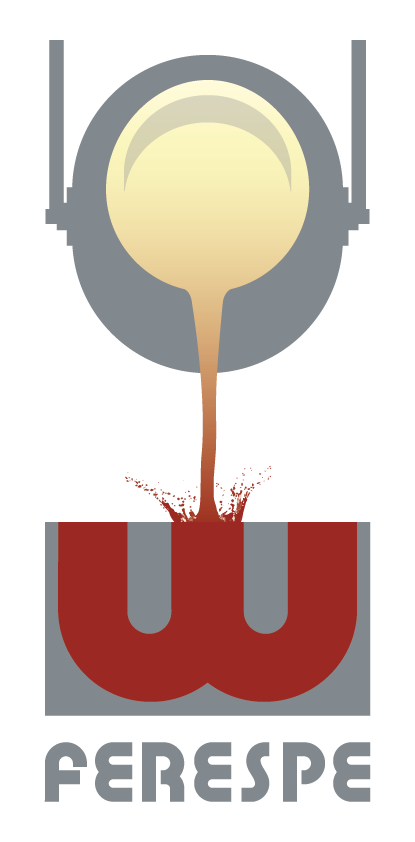Our Portugal 2020 projects
In-Situ-Cast
Project Name: In-Situ-Cast – Candidatura 033417
Project Code: POCI-01-0247-Feder-033417
Main Objective: Strengthen research, technological development and innovation.
Region of Intervention: North
Beneficiary Entity: FERESPE – Fundição Ferro e Aço,Lda e Universidade do Porto
Approval Date: 17-07-2018
Start Date: 01-09-2018
End Date: 30-08-2020
Total Elegible Costs: 283.102,81€
European Union Finance Support: 197.781,18€ FEDER
Goals, activities and expected/achieved results
Goals:
This project is in line with the growth strategy, competitiveness reinforcement and internationalization of Ferespe, through the development of differentiated and high added value products for the niche markets: “Construction machinery–Offshore and Onshore” e “Dredging equipment–Offshore and Onshore”. It is intended to be developed a new group of materials: composites with metallic matrix (MMC) reinforced with ceramic particles produced in-situ or ex-situ or reinforced with a ceramic foam, for the production of complex geometry components with high tribologic characteristics.
Activities
Selection and preparation of ceramic reinforcements; Production of samples; Macro and microstructural characterization; Chemical and mechanical characterization; Prototypes fabrication; Use of best methodology on other base materials; Results dissemination.
Results obtained
This project aimed to investigate and locally produce metal matrix composites (MMCs) in which the matrix of cast ferrous parts is reinforced with carbides. For this purpose, methodologies were developed to produce in-situ and ex-situ reinforcements that were introduced into the mold cavity. Self-drying sand molds and ceramic molds were used.
For the production of compacts, the following powder systems were tested: Ti+C, Ti+Al+C, Ti+Fe+C and WC+Fe. After the first tests, the Ti+Al+C and WC+Fe systems were selected. The titanium carbide (TiC) reinforcements were formed in-situ through self-sustaining high-temperature combustion (SHS) synthesis, while the tungsten carbide (WC) reinforcements were mainly produced with the ex-situ technique, using if mixtures of WC and Fe powders. Other methodologies were tested, such as the production of foams, which proved to be less efficient and were less explored.
With this approach, it was possible to develop technological solutions for three base materials produced by the company FERESPE – Fundição de Ferro e Aço, Lda: abrasion resistant cast iron (25%Cr) – class III and type A (ASTM A532/A532M- 10:2014), austenitic stainless steel GX5CrNiMo19-11-2 (ISO 4991:2015), and low carbon steel GP280GH (ISO 4991:2015).
The project began with the reinforcement of white high chromium cast iron, and reinforcements of TiC-MMC and WC-MMC were produced, using the in-situ and ex-situ methods, respectively. In the first case, several mixtures were prepared, having been selected as the most efficient one with Ti, Al and graphite powders in a mass fraction of 64:20:16, which were pressed in the form of green compacts, followed by the respective synthesis in situ, that is, the compact was fixed to the molding wall where the reinforcement was formed locally by the reaction of the powders with the liquid metal. In the second case, compacts were prepared from mixtures of WC and Fe in a volume fraction of 40:60. These compacts were sintered before being inserted into the moulding. The conditions that gave the best results were applied in the study of the remaining materials.
It should be noted that for an effective control of the reinforcements produced, it was necessary to understand the relationship between the phases formed in the composite zone, including the interface, and the resistance to abrasive wear, which required a very thorough microstructure analysis. In order to establish this relationship between processing, structure and properties, a microstructural characterization was carried out by optical microscopy (OM), scanning electron microscopy with energy dispersion spectrometry (SEM/EDS), backscattered electron diffraction (EBSD) ), transmission electron microscopy (TEM), and X-ray diffraction (XRD). Finally, to evaluate the effectiveness of the reinforcements, hardness and microabrasion wear tests (ball Cratering) were carried out.
In summary, the ferrous alloys studied were successfully reinforced using in-situ and ex-situ techniques applied using the FERESPE sand casting method. Microstructural analysis revealed a good bond between the reinforcement and the base metal for all samples produced. Both approaches provided a significant increase in abrasive wear resistance. WC-MMC reinforced high chromium white iron showed the best wear performance, with a wear rate about 60% lower than the base metal. In the case of austenitic stainless steel and low carbon steel, both reinforced with WC-MMC via ex situ, wear rates decreased by 45% and 39%, respectively.
They show that some of the techniques used to locally reinforce ferrous components have a high potential for industrialization, and can contribute to the development of differentiated products with high added value for new market segments. However, further developments are needed to optimize the process and allow the production of locally reinforced components with complex geometries. The project also highlighted the difficulty of applying these localized reinforcement techniques to precision casting.
The results obtained show that some of the techniques used to locally reinforce ferrous components have a high potential for industrialization, and can contribute to the development of differentiated products with high added value for new market segments. However, further developments are needed to optimize the process and allow the production of locally reinforced components with complex geometries. The project also highlighted the difficulty of applying these localized reinforcement techniques to precision casting.




